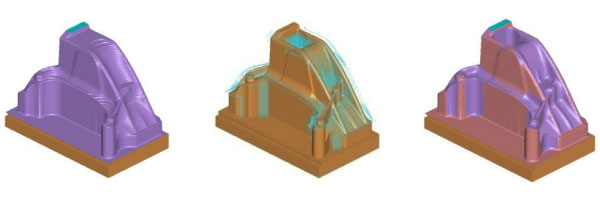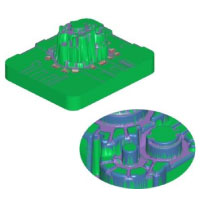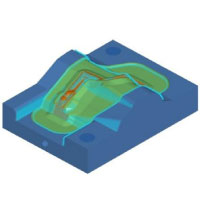|
|
 |
|
NCG CAM’s rest roughing can be done in two ways.
The user creates the first roughing toolpath from a solid block of material as previously described, in area clearance or core roughing. Rest roughing is then created automatically by selecting the next cutting tool, along with the previous toolpath(s). The rest roughing toolpath is created, eliminating fresh air cutting and only machining in the areas the previous cutting tool has left unmachined. Another stock model can then be made with the combined toolpaths to show the progression. |
 |
| Rest roughing can also be used when machining castings. The passes can be trimmed back to another surface model such as the casting form seen below on the right side. The resultant rest toolpath is fast to create and eliminates multiple tooling operations, fresh air cutting and set-up time. |
 |
|
Stock models can be created directly from one or more toolpaths. These models can be used for the visualisation of the machined part on the screen, without doing costly test cutting. Models can be sectioned with a clipping plane to show the machined and finished part together, thus allowing the user to see areas that have not been machined. These stock models can be used for rest machining subsequent operations, reducing the machining time and minimising fresh air cutting. |
 |
|
Waterline can be used for semi-finish and finish machining the steeper more vertical areas of a part. If a slope angle is specified, for example between 30 and 90 degrees, the steeper areas are machined. This leaves the shallower areas between 0.1and 35 degrees (using a 5 degree overlap), for more appropriate shallow area strategies. Waterline machining also has the feed-rate optimisation option available.
Linking options for waterline passes include bi-directional and one-way machining. Bi-directional machining will maintain contact with the part by climb milling one-way, then conventional milling the other, but should only be used for non-critical machining. One-way machining is the default and ensures a climb milling cutting action, maintaining optimum tool life, accuracy and good surface finish. It is also possible to set conventional milling if required. Eg: For cutting softer materials. |
 |
|
|
|
|

